Campus agriculture education: educating food citizens or producers?
HooverMacDonald JSE May 2017 14 Regenerative Agriculture PDF
1.0 Introduction:
In 1991, David Orr wrote, “It might have been different had agriculture evolved instead within the liberal arts colleges.” In this piece, written for the Society for Conservation Biology, Orr was lamenting the specialization of agricultural education within land-grant universities, and he argued that this resulted in a detrimental impact on the modern food system. Orr and others dreamed of a more holistic education for future farmers, rooted in ethics, land conservation, and civics—in short, the liberal arts tradition (Orr, 1991; Berry, 1977). Since Orr’s article in 1991, CAPs have seen an unprecedented growth in the U.S. We cover the growth of this movement in the last fifteen years, paying particular attention to the organizational structure of campus farms, curricular and co-curricular engagement, and the objectives of campus agriculture programs.
1.0 Introduction:
In 1991, David Orr wrote, “It might have been different had agriculture evolved instead within the liberal arts colleges.” In this piece, written for the Society for Conservation Biology, Orr was lamenting the specialization of agricultural education within land-grant universities, and he argued that this resulted in a detrimental impact on the modern food system. Orr and others dreamed of a more holistic education for future farmers, rooted in ethics, land conservation, and civics—in short, the liberal arts tradition (Orr, 1991; Berry, 1977). Since Orr’s article in 1991, CAPs have seen an unprecedented growth in the U.S. We cover the growth of this movement in the last fifteen years, paying particular attention to the organizational structure of campus farms, curricular and co-curricular engagement, and the objectives of campus agriculture programs.
Case studies, book series, and news articles have covered the resurgence of a 21st century “back to the land” movement (Sayre & Clark, 2011; Harris, 2011, Mitchel, 2015). Public interest in food related issues has grown to encompass new natural and organic supermarket sections; an explosion of alternative food markets, such as farmers markets, buying clubs, or CSAs; and new interest in food production, distribution, consumption, and the policy governing it all (Scherb, et al., 2012). Students are being introduced to these concepts in classes about the modern food system, but are also responding with campus and community programs that challenge the agriculture system (Barlett, 2011; Sayre & Clark, 2011).
Agriculture, or the act of growing food on college campuses, is nothing new. Colleges have trained future farmers for over a century and a half (Berry, 1977), but what has changed is the way in which students and educators are engaging with agriculture. For the last hundred years, agricultural education has been limited to large land-grant universities (MacRae, 1989), but grassroots campus agriculture movements are trying to change agriculture education in America. This research focuses on the development and direction of agricultural education outside of traditional land-grant agricultural schools by looking at the organizing structure of CAPs, student engagement and learning objectives, and faculty involvement. Throughtout this paper, we will look at the learning objectives and their impact on sustainability education, paying particular attention to the role they play in educating future farmers. A new generation of farmers is needed to ensure the resiliency, survival, and sustainability of agriculture in the U.S. Does campus agriculture educate that new generation of farmers, food processors, or policy experts that can help address the challenges faced in the current modern food system?
2.0 Background:
The health of a community relies on the health of the soil. People who work and rely upon the land have known that; farmers have known that. Over the last fifty years, the rest of our population has lost the knowledge that human survival and community wellbeing are inextricably tied to the soil. The 2012 Agriculture Census shows the continued trajectory of this long-term decline. Between 2007 and 2012, the number of farms decreased by 4.6 percent, while the average farm size increased (USDA, 2012). Additionally, in the same time period, the overall number of farmers decreased by 4.1 percent, and the average age of those farmers continued to increase from an average age of 50.5 in 1982 to 58.3 in 2012 (USDA, 2012). These trends, along with others to be discussed below, are challenging for our food system. However, there is a new generation trying to reconnect with the land through farming, many of which are younger and coming from outside of the land-grant education tradition (Harris, 2011; LaCharite, 2015; Mitchel, 2015).
In this section, we will briefly discuss modern agricultural development which many advocate was stimulated by land-grant educational institutions, as well as how they differ from the interdisciplinary nature of sustainability education. We will discuss the emerging pedagogical process in which students are trained to think critically and innovatively to address the local and global conditions of instability in our food system.
2.1 Modern Agriculture
Agricultural production has undergone immense change from a small-scale communal practice to large scale-global enterprises. The catalysts for the changes in agricultural production are accounted for well in other texts (Carolan, 2011; Tyson, 2004; Wilde, 2013), so they will not be expanded on here beyond touching on basic consequences of economic concentration, production practices, and food insecurity.
One in seven people worldwide do not know where their next meal will come from (Holt-Gimenez, 2009). Twenty years ago, this global food insecurity was supposed to have stopped, and hunger was going to be a thing of the past (Carolan, 2011). Not only is food insecurity persistent, but even more staggering is that food insecurity is not a “third-world” problem. Despite producing more calories per farmer, the U.S. is simultaneously a more obese and hungry population, and it isn’t just the U.S. Worldwide obesity continues to rise due to an influx of processed foods, particularly in the Americas (Carolan, 2011; FAO, 2015). Food insecurity is only a portion of the myriad of problems associated with food production. Environmental degradation (Hall, et. al., 2009), public health concerns (Finkelstein, et al, 2004; Frazao, 1999), food distribution and access (Carolan, 2013), and food sovereignty (Holt-Gimenez, 2009) are all major issues facing local and global populations.
The changes in our food system have had significant impacts that are being felt today, and their consequences, intended or unintended, are being argued in both academic and public discourse. Changes have led to increased consumption of processed foods, which in the same time frame have correlated with a rise in diet-related illnesses. According to a recent study, the share of America’s grocery budget spent on processed foods has almost doubled from 11.6 percent in 1982 to 22.9 percent in 2012 (Thuy Vo, 2012). Processed foods are now the largest share of American’s food budgets, eclipsing meat, fruits and vegetables, grains, and dairy. But what is the cost to developing this kind of food system? Per capita water use associated with agricultural has steadily increased since 1970, and when yields of commodity crops are considered relative to fuel input, the result is a decline of agricultural productivity (Carolan, 2011). When food transportation, storage, and marketing is considered, the energy required to maintain our modern food system is staggering (Carolan, 2011).
All of that processed food has significant payoffs for food markets. In the U.S., processed foods make up over one-third of total supermarket shares (USDA, 2015). Additionally, for both producers and consumers, the changes in the food system have meant severe economic concentration. In 2013, the top four supermarket firms (Wal-Mart, Kroger, Safeway, and Publix) controlled 36 percent of all grocery store sales (USDA, 2015). The same economic concentration exists for farmers who have seen markets contract. For the 2.2 million farmers in the U.S. there are only 25,000 food processors and 32,000 food wholesalers available to sell to. That is, for every 220,000 farmers there are only 2.5 food processors and 3.2 wholesalers (Carolan, 2011). This economic concentration gives an exorbitant amount of control to those top firms, which can translate to price manipulation for both the producers and consumers.
Many of the changes in the agriculture system were pursued in the name of progress and efficiency. Deeply rooted in the emergence and adoption of neoclassical economics, where land, labor, and capital were the measurements of true market success, and the agricultural revolutions devalued labor, diversity, and community in exchange for efficiency, standardization, and concentration. Many of these developments grew out of academic agriculture departments in the U.S. university system, where agricultural economists and production scientists were discovering new ways of growing in an effort to solve global food insecurity (Berry, 1977; Berry, 2009; Carolan, 2011; Lyson, 2004; MacRae, et al., 1989). The land grant policieis of the nineteenth century moved agriculture to a scientific disciplinary field with a positivist approach to agricultural development and education (Orr, 199; Berry, 1977; MacRae, et al. 1989). If, as Orr argues, the land grant system is partially to blame for our agricultural crisis, schools outside of traditional agriculture schools must be more involved in educating our furutre farmers.
2.2 Sustainability Education and the Campus Food Movement
Sustainability, and more specifically sustainable agriculture, is a wicked problem with a myriad of definitions, stakeholders, and solutions to the problems of environmental, social, and economic degradation (Peterson, 2013). However, despite being a wicked problem, the sustainability framework lends itself as an interdisciplinary approach to address twenty-first century problems (Peterson, 2013). Sustainability education, rooted in an interdisciplinary experiential approach, is required to educate students about the intersection of policy, economics, biology, sociology, and other disciplines to solve the complex problems plaguing our planet (Shriberg & MacDonald, 2013; Roberts, 2013). Colleges and universities around the U.S. have developed programs focused on sustainability education that are taking a trans-disciplinary approach to education and scholarship. Academic departments, administrative offices, research centers, and campus committees are working together to use the physical campus as a living learning laboratory to educate, research, and engage stakeholders in planning for and building a future that wisely manages resources in the name of sustainability (Fong, 2014; Ranalli, 2013). The alternative food movement is using the living learning laboratory model to to engage their campus communities around issues of food production, distribution, and security by setting aside land on campus, or purchasing land adjacent to campus (Biernbaum, 2011; Bramwell, et al, 2011; Duram, 2013; LaCharite, 2015; Sayre & Clark, 2011; Slotnick, 2011; Warburton, 2003).
Many of these campus agriculture efforts are located outside of the traditional land-grant agriculture schools and cite civic engagement, responsibility, and land stewardships as primary motivators of their programs (Anderson & Stuckey, 2011; LaChartie, 2015; Van Horn, 2011). While some of these campuses began CAPs during or before the “back to the land” movement of the 1970’s, many CAPs have begun just in the last fifteen years and are deeply rooted in the more recent paradigms of civic agriculture (Lyson, 2004), sustainable food systems (Hall, et. al., 2009; Heller & Keoleian, 2003), food justice (Alkon and Norgaard, 2009; Ageyman, et. al., 2002), and food security (Carolan, 2013). As schools develop campus agriculture programs rooted in experiential pedagogy it is important to ask what pedagogical models are being used and what are the resulting educational outcomes. For this paper, we will use Wesheimer and Kahne’s (2004) research on experiential pedagogy.
Experiential pedagogy can have many different educational objectives, but a common theme among experiential education programs is preparing young adults to be more engaged citizens (James & Iverson, 2009). Researchers Westheimer and Kahne (2004) argue that educational programs with a focus on civics or democracy fall into one of three major paradigms of citizenship – the personally responsible citizen, the participatory citizen, and the justice-oriented citizen. The personally responsible citizen understands their engagement as being well intentioned and full of character. They will act responsibly in their community through personal actions such as recycling or giving blood. This citizen, if understood in a food context, will grow his or her own garden, or he or she will shop in the organic section of the grocer or at the local farmers market. Secondly, the participatory citizen will engage with their community by participating in civic organizations, volunteering, or being a regular voter in local as well as national elections. This citizen understands the importance of collective action and community reciprocity as vital components of civic life. The participatory food citizen will organize food drives or volunteer at a food bank to address an immediate social concern of food insecurity. Lastly, the justice-oriented citizen is similar to the participatory citizen, but will take their engagement further to analyze the interconnection of economics, politics, and social prejudices that help to create a specific social ill. This food citizen will analyze what is causing food insecurity in their community and fight to change it through policy, social organizing, or business development. Westheimer and Kahne (2004) argue that educational programs develop students who fall into one of these three categories depending on the pedagogical process and the questions being asked within each program. Extrapolating Westheimer and Kahne’s (2004) research to food systems education helps clarify what kind of food citizen programs are preparing.
3.0 Methods:
Phase I of the research consisted of website content analysis of individual school websites in the Mid-Atlantic and New England region. To obtain a comprehensive comparison, each individual school’s website within the mid-Atlantic and New England region (666 schools) was searched for CAPs between December 2013 and June 2014. The search terms used included: sustainable food, sustainability, campus garden, campus farm, community garden, student farm, and agriculture. A basic content analysis of each website was conducted where major themes were analyzed and categorized in Microsoft excel. Beyond determining whether or not CAPs were present, the northeast inventory collected data points on a host of related content. This content included, but is not limited to, the types of the CAPs, their missions, their definitions of sustainability, the CAP initiation year, the CAP founding organizational structure, where the food produced is distributed, participation in the CAP, what participants go on to do beyond their experiences, and formal education related to sustainable food and agriculture in the northeast region. Formal education was identified by searching college and university websites and course catalogs using the search terms sustainable food, sustainability, garden, farm, agriculture, agroecology, permaculture, food justice, and eat. To be included, courses and degrees had to include both a component related to food and a component related to sustainability, with the exception that food courses in sustainability and environmental studies/sciences departments were included as well as sustainability focused courses within culinary programs. When complete data was not available on the school’s website, phone interviews were pursued with the listed contact for the CAP. The northeast schools from this data set are being used at the time of this writing because it is the most complete set of data from the larger nationwide data set.
Phase II of our research consisted of a national survey and ten focused interviews conducted between March 2014 and August 2014. The survey was open to responses between March 2014 and May 2014. An initial survey of 40 questions was distributed through three primary modes. In late March, the survey and a description of the research were sent through the Community Foods email listsev hosted by Tufts University and the Green Schools email listserv hosted by Brown University. As of June 2015, these two listservs boast a combined membership of over 7,000 people, with overlap between the two. The listservs are highly utilized by professionals, researchers, and faculty working in the higher education sustainability movement and the alternative food movement. The call for participation was titled “The Campus Agriculture Movement – Seeking Research Participants” and invited participation by anyone who had a campus farm or garden associated with their college or university in any capacity.
Second, the Association for the Advancement of Sustainability in Higher Education (AASHE) placed a call for survey participants in their weekly email bulletin. AASHE is the international professional organization for the advancement of sustainability in higher education. Their weekly bulletin is distributed to approximately 9,700 self-subscribers.
Third, professionals, faculty, or students involved with campus agriculture projects were contacted directly with a description of the research, a link to the survey, and a request to participate. Contact information was collected through two lists associated with AASHE. Campuses with agriculture projects are listed under two different categories in AASHE’s resources tab. The two lists, “Campus Supported Agriculture and Farms” and “Campus and Campus-Community Gardens,” contain 72 and 147 schools respectively, with links to either press-releases, institutional web pages, or associated blogs. These lists are available to AASHE member institutions, but it should be noted that they are not exhaustive lists of Colleges or Universities with campus agriculture projects. Contact information was collected by visiting the websites of these institutions. Many websites linked in the two AASHE lists were either no longer available, or contact information was not listed in the webpage, resulting in the need to search for contact information on institutional webpages which sometimes proved difficult to find.
After the initial survey, ten phone interviews were conducted between June and July 2014. Of the 105 survey responses, fifty-five were willing to be contacted for a follow-up phone interview. Of those, ten were selected for interviews from random pools of varying sized institutions. The interviews were thirty minute semi-structured with consistency in questions between interviews, and some open-ended questions. Interviews were transcribed and major themes analyzed.
4.0 Results:
4.1 Campus Agriculture Profiles:
Campus Agriculture Programs (CAPs) look different depending on the climate, available space, and stated purpose of the program. Results from this research on campus agriculture profiles such as acreage, founding year, and institutional type and size mirror almost exactly the research conducted by Keri LaCharite (2015) in her article titled “Re-visioning agriculture in higher education: the role of campus agriculture initiatives in sustainability education.” As a result, we will not report them here, but spend our time reporting on student and academic engagemet and program outcomes.
4.2 Student and Academic Engagement
Farming is hard work and teaching about farming in an educational environment presents its own challenges and opportunities. Unlike on a traditional farm, CAPs are situated in a microcosm of institutional structure. In both the national survey and the northeast inventory, the overwhelming organizational structure for campus agriculture projects were student run. Of note in organizational structure and funding source is the rise in Sustainability Office oversight and the decline in Academic Departments. “Other” responses for structure included Dining Services, Single Professor, Guerrilla Student Effort, Collaboration between Offices & Academic Departments, and Outside Non-Profit. Funding sources have also followed a similar trajectory as the organizational structure of CAPs. In the earlier days, outside grants were a significant funding source of many programs; however, that has diminished over time. The increase in sustainability office management and institutionally based funding sources indicate an adoption of these programs as important components of campus sustainability practices and education. However, questions remain about their role in campus sustainability efforts and institutional missions.
As noted, students are the primary leaders of campus agriculture programs. Students have a desire to engage with the world around them, and CAPs are offering many engagement opportunities to address that desire. Figure 1 shows that students primarily engage with CAPs through volunteer opportunities. According to the northeast inventory, over 4,000 students have engaged in CAPs in some capacity on an annual basis. A consistently emphasized challenge in both the national survey and northeast inventory was the challenge programs faced between May and August when students were not around. To combat this challenge, some programs hired students to work over the summer.
The majority of programs hire at least one or two students to work in the summer, with some hiring upwards of 5 or more (Figure 2). Consistent through most of the interviews, participants indicated that they paid their students between $8 and $10 per hour, and due to institutional rules, students were never allowed to work more than 40 hours in a week. In many cases, institutions had student labor limits of 20 hours or less.
In addition to student engagement, Figure 3 shows how CAPs might be used for academic engagement. Classes engage with CAPs on a marginally higher level than faculty or student research. 31 percent of respondents said that classes engage with campus agriculture “often” or “regularly.” Interviewees were clearly aware of the disconnect between their CAP and academic engagement:
“One of the things that’s a real weakness of our program is that we don’t have a strong curricular attachment.”
“One of the challenges at our school is that there isn’t a particular academic unit or specific faculty member that it falls within their purview.”
“I see such a disconnect in the liberal arts community between this idea of how important agriculture is and what they believe is important. There are faculty in environmental studies who do not see agricultural education as valuable.”
“We offer a work experience class like an internship. We are trying to not use it for labor. We do field trips to other farms, tomato grafting workshop, and those kind of things. We don’t have a sustainable agriculture class. [The farm] needs to have a curriculum designed for it. The educational aspect of the farm is essentially the volunteers at the farm.”
The students and faculty who do engage with CAPs on a regular basis typically come from similar disciplines. Two survey questions asked participants to name the top three academic departments from which student leaders engage and which faculty most utilize Campus Farms/Gardens for educational purposes. Environmental Studies is the top discipline for both student (31 percent) and faculty (23 percent) engagement. Second to Environmental Studies for both faculty (13 percent) and students (15 percent) is Biology. “Other” responses in both categories were Sustainability, Food Studies, Nutrition, and Engineering. (For a full list of disciplines using CAPs for educational purposes, see Appendix A).
4.3 Outcomes:
Lastly, participants were asked about the priority given to produce distribution practices, educational outcomes, the level of community engagement, and student’s post-graduation pursuits. As seen in Table 2, selling food through community-supported agriculture or farmers markets is a relatively low priority for many programs. Most programs operate on a community garden or food donation model, with a split in CAPs attempting to work with their campus-dining provider. During interviews from the national survey, rational for where food goes ranged from the following:
“We do a farmers market in town, but I don’t really want to be in competition with other farmers.”
(Working with a dinning operations) “The drawbacks are that, whatever we grow for them has to be in bulk. It doesn’t really work for us to do a lot of interesting things; they just want 400lbs of tomatoes a week. They want a huge shipment of potatoes.”
“We had [dining provider omitted] as our dining provider, which proved to be problematic in accepting the food that we grew. They were willing to take donations, but were not willing to pay. We are one year into having [provider omitted]as our dining service provider and the sustainable food loop has come to fruition as an actual thing instead of theoretical. [Provider omitted] will buy all the food that we give them.”
“We have a lot of donation outlets, but no other market outlets.”
Survey respondents were also asked to prioritize student educational outcomes from a list of eighteen possible choices. Figure 4 shows the priority of educational outcomes from the highest to lowest priority. As seen in Figure 4, animal husbandry is a low priority, so it is not surprising then that more than half of survey respondents (68 percent) have no livestock associated with their programs. Of those that do have livestock, the majority of programs had chickens (17 percent), sheep (6 percent), pigs (5 percent), cows (4 percent), goats (3 percent), or alpaca (1 percent). Many respondents took the opportunity to answer “other” (17 percent) on the livestock question, with most respondents writing in that they had either bees or tilapia.
Along side the rise of campus agriculture programs, specific food-related academic programs are also on the rise. The northeast inventory, formal education related to sustainable food and agriculture were identified. Through this search, 963 courses, 11 four-year undergraduate degrees, six undergraduate minors, 10 associate degrees, 12 certificates, 18 concentrations, 10 centers or institutes, and four masters or PhD-level degrees were identified in the northeast alone. However, there was no evidence that these formal educational opportunities work in parallel with the emerging CAPs.
Interview responses provided some further insight into academic integration of CAPs:
“We don’t really have agricultural education. What we have is experiences that allow students to garden during their college years if they choose to join that club.”
“Having some kind of food growing ability is very important generally. A lot of our students, even if they aren’t going into more horticultural jobs, that they still have that responsibility of keeping something alive in the field and grow a crop is really important.”
“It’s not just about knowing where your food comes from, for students to see themselves as members of the food system”
[The farm is to] “get students some kind of hands on experience with food production. Not so much that they will learn how to be a farmer themselves… it’s more that they are getting that experience of where food comes from; that it actually grows in the earth.”
“The number one value of having a food/farm/ag program at any college is to constantly generate the possibility of having students understand their place within a foodshed”
Lastly, how does the hands on education students receive in CAPs translate to further work or study in the food system. Figure 5 shows that a third of respondents said they did not know of any students who went to pursue work or further study in the food system; however, two-thirds of respondents knew of at least one or more students that continued work upon graduation. When respondents were asked what type of work they were doing now, many answered that students went on to work in education, advocacy, public policy, organic farming (either as apprentices or starting their own farms), restaurant businesses, and an abundance in non-profits focused on food access, nutrition, therapy, and/or education. Despite two-thirds of respondents knowing at least one person working in the food system, many individuals reported that they only had limited anecdotal evidence on what their students have gone on to do, and wished they had done a better job of tracking alumni information.
5.0 Discussion & Conclusion:
The campus agriculture movement is relatively young. Eighty-seven percent of programs represented in the national survey and over ninety percent of the institutions inventoried in the northeast study were started after 2001. In those 14 short years, the campus agriculture movement has established itself as an important part of a campus fabric. However, campus agriculture programs need to be intentional in the next 15-20 years to more strategically identify the educational objectives and pedagogical processes of their programs.
CAPs place a high emphasis on “Food Justice,” “Food Democracy,” and “Community Development.” Seeing these results in light of Westheimer and Kahne (2004) might indicate that campus agriculture programs are emphasizing a justice-oriented citizenship model. Although more research needs to be done that studies the learning outcomes of the students’ associated with CAPs, the leaders of campus agriculture programs are viewing their work as training justice-oriented food citizens. However, while national survey respondents seem to be focused on justice-oriented education in their objectives, interview respondents rarely talked about food justice as a goal. Most interviewees talked about the need for students to see that they are simply participants in the food system, and that their food comes from the earth. The interviewees focus on personal reflection as an educational outcome is closer to a personal responsible citizen model instead of the justice-orientation as stated in the survey. Given the increase in Sustainability Office’s providing leadership for CAPs, it is not surprising that 93 percent of respondents identified “General Sustainability” as being a High or Medium priority for student learning outcomes. What is surprising is that of the top 10 priorities for educational outcomes, only two educational objectives are specific to food production, “Sustainable Ag” and “Agroecology.” Additionally, Figure 8 shows low educational priorities of agriculture production education such as integrated pest management (IPM), animal husbandry, or agricultural economics. If campus agricultural programs outside of land grant schools are indeed training future farmers, there should be an increased emphasis on more tangible agricultural education. Goals and objectives for campus agriculture programs should be looked at more closely to help clarify the purpose of campus agriculture education outside of land-grant universities.
Farmers continue to decrease as a percentage of the overall population, and the median age of farmers is beginning to reach retirement age (USDA, 2012). We need not only more farmers, but younger farmers. According to the national survey, 66 percent of CAP students graduate and go on to work or study in the food system, and CAPs can play a vital role in this process, and need to be champions for stronger domestic farm policy that incentivizes farming as a vocation (Figure 9). Ranalli (2013) argues that there is no better way to re-engage young adults with the natural world than for them to farm. He articulates that “We should treat agricultural labor as a national service, and organize and reward it accordingly.” Ranalli’s proposal for a FarmCorps program similar to that of AmeriCorps where young professionals are encouraged to serve in the form of food production and food system management might serve as a development opportunity for rural communities in a similar way AmeriCorps has served urban communities. The benefits are that “producers will have a reliable, reputable source of local seasonal labor. Schools will have new service-learning opportunities that could be linked up with classroom teaching” (Ranalli, 2013). Agricultural service and programs such as these exist, but in more informal structures. On farm training programs that do exist, such as apprentice programs or non-profit educational farms, however, there is very little connection between programs. International programs such as World Wide Opportunities on Organic Farms (WWOOF), the Peace Corps, or religious programs such as Mennonite Central Committee provide opportunities for farm specific service. Some service is available domestically through WWOOF-USA, but most U.S.-based service opportunities contain an urban bias. Campus agriculture programs and just food system advocates should consider Ranalli’s call and use the network of campus agriculture programs to build a national “FarmCorps” service model.
In thinking about training new farmers, it is important to note that the Northeast, the Pacific, and parts of the Midwest are seeing a rise in younger farmers (Mitchel, 2015; Harris, 2011). The 2012 USDA Census shows there to be a high concentration of beginning farmers in New England and the Pacific with these regions seeing upwards of a 30 percent increase in beginning farmers (USDA, 2012). More research is needed to understand why these regions are experiencing a growth in small-scale beginning farmers, but it is worth noting that the regions experiencing an increase of young farmers are also home to a higher concentration of CAPs. Results from this research cannot make a strong enough connection between the rise of young farmers and CAPs.
Lastly, as with any agricultural practice, inputs in the form of soil, water, sun, and labor hopefully lead to an output in the form of an agricultural product. Campus agriculture programs are in a unique position to decide how they will participate in the food system with their products. Many early campus agriculture programs and large campus farms are trying to strike a balance between production for financial sustainability and the educational mission of the college (Syre & Clark, 2011), but many of the newer programs (87 percent) have not even gotten to the point of worrying about production versus education. Table 2 and Figure 4 show that many programs are focused on community gardening and food donations as high priorities, with revenue generating programs such as farmers markets or CSA’s as lower priorities, with dining hall sales unpredictable depending on the institution and dining hall provider.
However, while data from this research shows lower priorities for revenue generation, some literature shows some college campuses are beginning to offer food markets directly on campus through partnerships with other farms. This is part of a larger trend in the local food movement where it is common for local farms to offer CSA pick-ups or farmers markets at places of employment (McCollum, 2014).
The programs that do sell at farmers market, campus markets, or dining halls express benefits and challenges that are worth discussing. This research was not focused on dining hall providers, but dining services was commonly discussed by interviewees. As is fairly common for colleges and universities, contracted dining service companies provide dining options for many campuses interviewed for this research. They include Sodexo, Aramark, Bon Appétit, Chartwells, and more. Although certain providers tended to be more engaged in CAPs than others, many interviewees indicated challenges with providers. The most common challenges were associated with either the price dining services were willing to pay for the produce, or a mismatch between the desired quantity by the provider and quantity produced by the CAP. Some CAPs also had challenges fulfilling health safety certification standards mandated by the institution. With the rise of campus agriculture, major campus food service providers should consider ways in which they can participate in the educational process by purchasing food from campus agriculture projects and helping to expand the economic education of food production to include growing for wholesale markets.
5.1 Conclusion
Food systems are becoming a ubiquitous part of the academy, from course work to campus farms. Some of the projects have been championed by students, others by faculty or staff, but no matter who started them, the last fifteen years has seen the beginnings of a move that brings agriculture education beyond the campuses of land-grant institutions. Deeply rooted in experiential pedagogy and a strong emphasis on educating more involved food citizens, campus agriculture is a strong component of sustainability education. However, this young movement is not yet an established part of curriculum at many schools despite a rise in food related courses (Holt, 2015). Campus agriculture professionals need to continue local and national conversation that will define agricultural education over the next fifteen to twenty years. Would it look different “had agriculture evolved instead within the liberal arts colleges” (Orr, 1991)? Campus sustainability efforts are forcing change in our food system, but what role do campus agriculture programs play in that change. This paper gives a snapshot into the overall movement, and begins to identify its educational role over the last fifteen years. However, questions still remain surrounding campus agriculture’s ability and efficacy to train future food system professionals, from farmers to policy makers. We hope this is a call for greater purpose and further research into campus based food production programs.
Acknowledgements:
Support for the northeast inventory component of this study was provided by [Name Redacted]
References:
AASHE (2012). Resources: Campus and Campus and Campus Community Gardens. (March 2014) Retrieved from http://www.aashe.org/resources/campus-and-campus-community-gardens
Agyeman, J., Bullard, R. D., & Evans, B. (2002). Exploring the nexus: Bringing together sustainability, environmental justice and equity. Space and polity, 6(1), 77-90.
Alkon, A. H., & Norgaard, K. M. (2009). Breaking the Food Chains: An Investigation of Food Justice Activism. Sociological Inquiry, 79(3), 289-305.
Anderson, M., & Stuckey, R. (2011). Wilmington College: Balancing Education and Profitability. In Sayre, L., & Clark, S. (Eds.), (2011). Fields of Learning: The student farm movement in North America (pp. 51-69). Lexington, KY: The University Press of Kentucky.
Barlett, P. (2011). Campus Sustainable Food Projects: Critique and Engagement. American Anthropologist, 113 (1), 101-115.
Berry, W. (1977). The Unsettling of America: Culture and Agriculture. Sierra Club Books.
Berry, W. (2009). Money versus Goods. In Berry, W. What Matters? Economics for a renewed commonwealth (pp. 3-30). Berkley: Counterpoint.
Biernbaum, J. (2011). Michigan State University: Four Season Student Farming. In Sayre, L., & Clark, S. (Eds.). (2011). Fields of Learning: The student farm movement in North America (pp. 289-305). Lexington, KY: The University Press of Kentucky.
Bramwell, S., Rosemeyer, M., & Barker, M. (2011). Evergreen State College: Interdisciplinary Studies in Sustainable Agriculture. In Sayre, L., & Clark, S. (Eds.), (2011). Fields of Learning: The student farm movement in North America (pp. 89-108). Lexington, KY: The University Press of Kentucky.
Carolan, M.S.(2013). Reclaiming food security. New York: Routledge.
Carolan, M.S. (2011). The Real Cost of Cheap Food. New York: Routledge.
Duram, L.A., & Williams, L.L. (2015., Growing a student organic garden within the context of
University sustainability initiatives. International Journal of Sustainability in Higher Education. 16(1), 3-15.
Food and Agriculture Organization (FAO). (2015). The state of food insecurity in the world. Rome, Italy: Food and Agriculture Organization of the United Nations.
Finkelstein, E. A., Fiebelkorn, I. C., & Wang, G. (2004). State‐Level Estimates of Annual Medical Expenditures Attributable to Obesity. Obesity research,12(1), 18-24.
Fong, B. (2014). Civic Engagement is an essential element of a College Education. Huffington Post.
http://www.huffingtonpost.com/bobby-fong/civic-engagement-is-an-es_b_4962740.html
Gatrell, J. D., Reid, N., & Ross, P. (2011). Local food systems, deserts, and maps: the spatial dynamics and policy implications of food geography. Applied Geography, 31(4), 1195-1196.
Hall, K. D., Guo, J., Dore, M., & Chow, C. C. (2009). The progressive increase of food waste in America and its environmental impact. PloS one, 4(11), e7940.
Harris, S. (2011). Farmers Under 40: Liberal arts students try their hand at farming. http://www.northcountrypublicradio.org/news/story/18013/20110714/farmers-under-40-liberal-arts-students-try-their-hand-at-farming
Heller, M. C. & Keoleian, G. A. (2003). Assessing the sustainability of the US Food system: a life cycle perspective. Agricultural Systems, 76 (3), 1007-1041.
Holt, S. (2015). Majoring in Food: Colleges Offering More Courses, Degrees. Civil Eats. Retrieved from http://civileats.com/2015/09/22/majoring-in-food-colleges-offering-more-courses-degrees/
Holt-Giménez, E. (2009). From food crisis to food sovereignty. Monthly Review, 61(3), 142-56.
James, J. H., & Iverson, S. V. (2009). Striving for Critical Citizenship in a Teacher Education Program: Problems and Possibilities. Michigan Journal of Community Service Learning, 16(1), 33-46.
LaCharite, K. (2015). Revisioning Agriculutre in higher education: the role of campus agriculture initiatives in sustainability education. Agriculture and Human Values. 1-15.
MacRae, R. J., Hill, S. B., Henning, J., & Mehuys, G. R. (1989). Agricultural science and sustainable agriculture: a review of the existing scientific barriers to sustainable food production and potential solutions. Biological agriculture & horticulture: An internatonal Journal for sustainable production systems. 6(3), 173-219.
McCollum, M. (2014). More Wisconsin Employers Set Up CSA Drop-Off Sites At The Workplace. http://www.wpr.org/more-wisconsin-employers-set-csa-drop-sites-workplace
Mitchel, J. (2015). A Young Generation Sees Greener Pastures in Agriculture. All Things Considered. Retrieved from http://www.npr.org/2015/01/03/374629580/a-young-generation-sees-greener-pastures-in-agriculture?sc=tw
Orr, D. (1991). Biological Diversity, Agriculture, and the Liberal Arts. 5(3), 268-270
Peterson, H.C. (2013). Sustainability: A Wicked Problem. In Kebreab, E. (Ed.). (2013). Sustainable Animal Agriculture. (pp. 1 – 9) Boston, MA: CABI.
Ranalli, B. (2013). “FarmCorps”: A national service program in agricultural labor for youth?. Journal of Sustainability Education. Vol. 5
Roberts, J. (2013). Experiencing Sustainability: Thinking Deeper About Experiential Education in Higher Education. Journal of Sustainability Education. Vol. 5
Sayre, L., & Clark, S. (Eds.). (2011). Introduction. In Sayre, L., & Clark, S. (Eds.).(2011). Fields of Learning. (pp. 1-28). Lexington. University Press of Kentucky.
Slotnick, J. (2011). University of Montana: Agriculturally Supported Community. (Eds.), (2011). Fields of Learning: The student farm movement in North America (pp. 227-245). Lexington, KY: The University Press of Kentucky.
Shriberg, M., & MacDonald, L. (2013). Sustainability Leadership Programs: Emerging Goals, Methods, and Best Practices. Journal of Sustainability Education. Vol. 5
Sustainable Endowments Institute. (2009). The College Sustainability Report Card, Categories: Food and Recycling. http://www.greenreportcard.org/report-card-2009/categories/food-recycling
Thuy Vo, L. (2012, Nov 1). What America Spends on Groceries. Article retrieved from http://www.npr.org/sections/money/2012/06/08/154568945/what-america-spends-on-groceries
USDA (2012). Census of Agriculture. Retrieved from http://www.agcensus.usda.gov/Publications/2012/
USDA (2015). Economic Research Service: Retail Trends. Retrieved from http://www.ers.usda.gov/topics/food-markets-prices/retailing-wholesaling/retail-trends.aspx
Van Horn, M. (2011). University of California Davis: Moving from the margins toward the center. In Sayre, L., & Clark, S. (Eds.), (2011). Fields of Learning: The student farm movement in North America (pp. 129-148). Lexington, KY: The University Press of Kentucky.
http://www.agcensus.usda.gov/Publications/2012/
Warburton, K. (2003). Deep learning and education for sustainability, International Journal of
Sustainability in Higher Education, 4 (1) pp. 44-56
Westheimer, J. & Kahne, J. (2004). What Kind of Citizen? The Politics of Educating for Democracy. American Educational Research Journal, 41 (2) pp.237-269.
Appendix A:







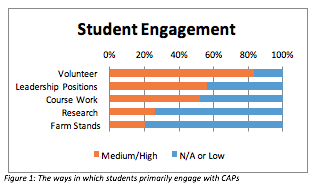
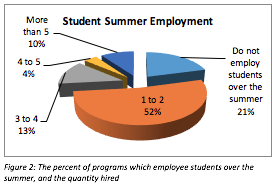
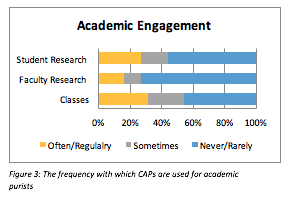
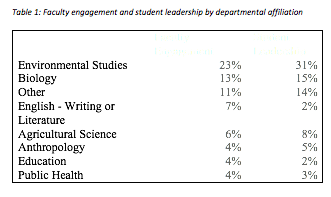
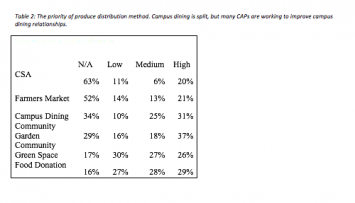
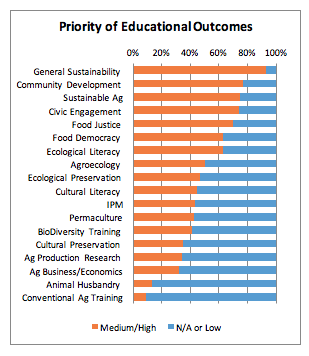
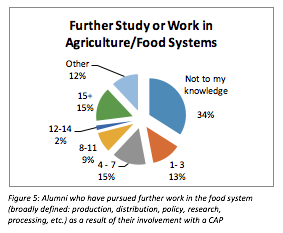
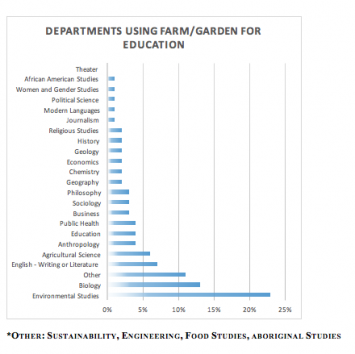



 Brandon is the Director of Sustainability at Messiah College located in Central Pennsylvania, where he provides leadership to both campus sustainability initiatives and the Sustainability Studies major, both of which cultivate an ethos of civic and ecological citizenship through experiential learning and institutional sustainability planning. Essentially this means his work has him all over campus, from working in the garden or managing composting efforts to teaching and research. His passion for educating students to become more engaged citizens, both socially and ecologically fits well in the sustainability framework. Brandon's teaching and research focuses on community and urban development, with a particular focus on food systems, economic geography, local policy, and human-environment interactions.
Brandon is the Director of Sustainability at Messiah College located in Central Pennsylvania, where he provides leadership to both campus sustainability initiatives and the Sustainability Studies major, both of which cultivate an ethos of civic and ecological citizenship through experiential learning and institutional sustainability planning. Essentially this means his work has him all over campus, from working in the garden or managing composting efforts to teaching and research. His passion for educating students to become more engaged citizens, both socially and ecologically fits well in the sustainability framework. Brandon's teaching and research focuses on community and urban development, with a particular focus on food systems, economic geography, local policy, and human-environment interactions.  Lindsey MacDonald graduated with a Master of Science degree from the School of Natural Resources and Environment at the University of Michigan in 2013. Throughout her time at Michigan, she facilitated leadership development for the Graham Sustainability Scholars Program. She also worked to start a Sustainable Food Program and Campus Farm, where food is used as an avenue for teaching sustainability leadership.
Lindsey MacDonald graduated with a Master of Science degree from the School of Natural Resources and Environment at the University of Michigan in 2013. Throughout her time at Michigan, she facilitated leadership development for the Graham Sustainability Scholars Program. She also worked to start a Sustainable Food Program and Campus Farm, where food is used as an avenue for teaching sustainability leadership. 
